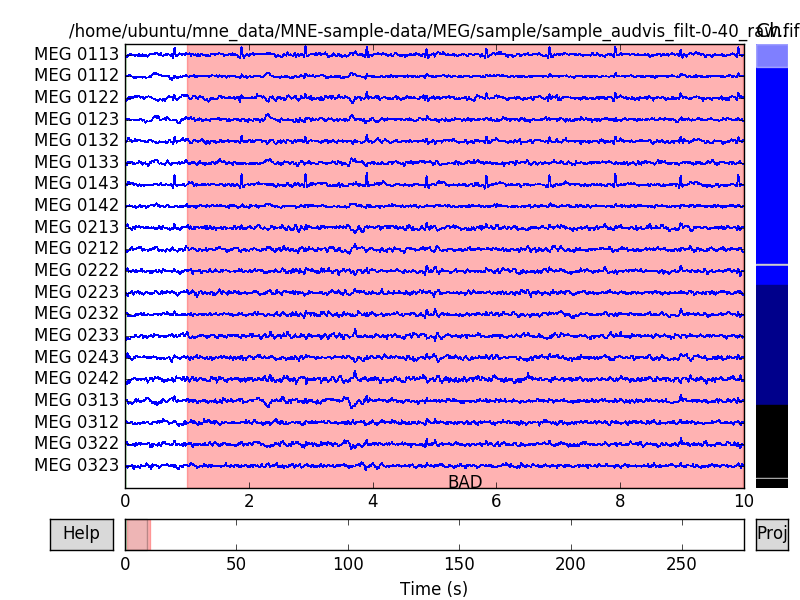ICA is fit to MEG raw data. The sources matching the ECG and EOG are automatically found and displayed. Subsequently, artifact detection and rejection quality are assessed.
# Authors: Denis Engemann <denis.engemann@gmail.com>
# Alexandre Gramfort <alexandre.gramfort@telecom-paristech.fr>
#
# License: BSD (3-clause)
import numpy as np
import mne
from mne.preprocessing import ICA
from mne.preprocessing import create_ecg_epochs, create_eog_epochs
from mne.datasets import sample
Setup paths and prepare raw data.
data_path = sample.data_path()
raw_fname = data_path + '/MEG/sample/sample_audvis_filt-0-40_raw.fif'
raw = mne.io.read_raw_fif(raw_fname, preload=True)
raw.filter(1, 45, n_jobs=1, l_trans_bandwidth=0.5, h_trans_bandwidth=0.5,
filter_length='10s', phase='zero-double')
raw.annotations = mne.Annotations([1], [10], 'BAD')
raw.plot(block=True)
# For the sake of example we annotate first 10 seconds of the recording as
# 'BAD'. This part of data is excluded from the ICA decomposition by default.
# To turn this behavior off, pass ``reject_by_annotation=False`` to
# :meth:`mne.preprocessing.ICA.fit`.
raw.annotations = mne.Annotations([0], [10], 'BAD')

# Other available choices are `infomax` or `extended-infomax`
# We pass a float value between 0 and 1 to select n_components based on the
# percentage of variance explained by the PCA components.
ica = ICA(n_components=0.95, method='fastica')
picks = mne.pick_types(raw.info, meg=True, eeg=False, eog=False,
stim=False, exclude='bads')
ica.fit(raw, picks=picks, decim=3, reject=dict(mag=4e-12, grad=4000e-13))
# maximum number of components to reject
n_max_ecg, n_max_eog = 3, 1 # here we don't expect horizontal EOG components
title = 'Sources related to %s artifacts (red)'
# generate ECG epochs use detection via phase statistics
ecg_epochs = create_ecg_epochs(raw, tmin=-.5, tmax=.5, picks=picks)
ecg_inds, scores = ica.find_bads_ecg(ecg_epochs, method='ctps')
ica.plot_scores(scores, exclude=ecg_inds, title=title % 'ecg', labels='ecg')
show_picks = np.abs(scores).argsort()[::-1][:5]
ica.plot_sources(raw, show_picks, exclude=ecg_inds, title=title % 'ecg')
ica.plot_components(ecg_inds, title=title % 'ecg', colorbar=True)
ecg_inds = ecg_inds[:n_max_ecg]
ica.exclude += ecg_inds
# detect EOG by correlation
eog_inds, scores = ica.find_bads_eog(raw)
ica.plot_scores(scores, exclude=eog_inds, title=title % 'eog', labels='eog')
show_picks = np.abs(scores).argsort()[::-1][:5]
ica.plot_sources(raw, show_picks, exclude=eog_inds, title=title % 'eog')
ica.plot_components(eog_inds, title=title % 'eog', colorbar=True)
eog_inds = eog_inds[:n_max_eog]
ica.exclude += eog_inds
# estimate average artifact
ecg_evoked = ecg_epochs.average()
ica.plot_sources(ecg_evoked, exclude=ecg_inds) # plot ECG sources + selection
ica.plot_overlay(ecg_evoked, exclude=ecg_inds) # plot ECG cleaning
eog_evoked = create_eog_epochs(raw, tmin=-.5, tmax=.5, picks=picks).average()
ica.plot_sources(eog_evoked, exclude=eog_inds) # plot EOG sources + selection
ica.plot_overlay(eog_evoked, exclude=eog_inds) # plot EOG cleaning
# check the amplitudes do not change
ica.plot_overlay(raw) # EOG artifacts remain
# To save an ICA solution you can say:
# ica.save('my_ica.fif')
# You can later load the solution by saying:
# from mne.preprocessing import read_ica
# read_ica('my_ica.fif')
# Apply the solution to Raw, Epochs or Evoked like this:
# ica.apply(epochs)
Total running time of the script: ( 0 minutes 54.455 seconds)